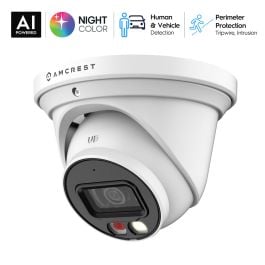Peeper
Young grasshopper
I have two rock columns, one on each side of my driveway. Each column has an IP turret cam facing the street. These two cameras, using "out of the box" settings:

 empiretech01.com
empiretech01.com
Each turret cam is about the same distance from the vehicle in the pictures. The vehicle is roughly 100 feet away.
The 4k Amcrest camera has a 2.8mm fixed lens, with 1/2.8 sensor. The 4MP Empiretech camera has a 2.8-12mm lens, with 1/1.8 sensor, set at maximum zoom (12mm)
Below are the images. They have been cropped to focus on a comparison of the vehicle.
4k screenshot with no optical zoom and no digital zoom, versus 4MP screenshot with max optical zoom but no digital zoom:
4k screenshot with no optical zoom plus 3x digital zoom, versus 4MP screenshot with max optical zoom plus 3x digital zoom:
Upon review, there is obvious evidence presented that the optical zoom and different sensor in the 4MP camera presents a significantly better image than a 4k camera with a 1/2.8 sensor.
Question-- any suggestions on camera settings to change to improve a nighttime image? Both cameras are using unaltered factory settings.
amcrest.com" data-pending="false">

 amcrest.com
amcrest.com
Amcrest 4K Night Color IP PoE Turret Cam IP8M-2779EW-AI (White)
AI FEATURES & DUAL ILLUMINATION – AI Turret PoE IP Camera features Human & Vehicle Detection, IVS (Tripwire, Intrusion Detection) which triggers an event anytime a human or vehicle crosses the defined area (prevents false alerts). Dual illumination night vision with Full NightColor warm/white...

EmpireTech IPC-T54IR-ZE-S3 1/1.8" CMOS 4MP IR Starlight 2.7mm–12mm Var
The EmpireTech IPC-T54IR-ZE-S3 offers advanced features such as a 4MP 1/1.8" CMOS image sensor, 40 m max. illumination distance with integrated IR LED, deep learning algorithms for face and object recognition, 512GB Micro SD card slot, built-in microphone, IP67 rating, and SMD 3.0 support.
 empiretech01.com
empiretech01.com
Each turret cam is about the same distance from the vehicle in the pictures. The vehicle is roughly 100 feet away.
The 4k Amcrest camera has a 2.8mm fixed lens, with 1/2.8 sensor. The 4MP Empiretech camera has a 2.8-12mm lens, with 1/1.8 sensor, set at maximum zoom (12mm)
Below are the images. They have been cropped to focus on a comparison of the vehicle.
4k screenshot with no optical zoom and no digital zoom, versus 4MP screenshot with max optical zoom but no digital zoom:
4k screenshot with no optical zoom plus 3x digital zoom, versus 4MP screenshot with max optical zoom plus 3x digital zoom:
Upon review, there is obvious evidence presented that the optical zoom and different sensor in the 4MP camera presents a significantly better image than a 4k camera with a 1/2.8 sensor.
Question-- any suggestions on camera settings to change to improve a nighttime image? Both cameras are using unaltered factory settings.
Attachments
-
28.6 KB Views: 88
-
98.7 KB Views: 90
-
18.5 KB Views: 89
-
71.6 KB Views: 86
Last edited:











